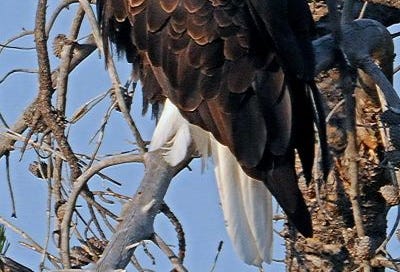January: The Bald Eagle
Make no mistake about the bald eagle: This majestic bird and long-standing emblem of the United States of America is far from bare-headed. Etymologically speaking, the English word “bald” may have origins with a Celtic word bal, meaning "white patch, blaze" especially on the head of a horse or other animal. The bald eagle, then, is not lacking feathers on its head, but rather it is called “bald” because it is white on top.
Bald eagles do not achieve their classic look until they are four or five years old. Together with a crown of white feathers, a white neck, pale yellow eyes, yellow legs and hooked yellow bill, brown body, brown wings, and white tails, this majestic bird is also a massive bird: adults weigh six to 14 pounds. Female bald eagles are slightly larger than males, with dimensions usually around three feet tall and having a wingspan of eight feet.
The bald eagle belongs to the Haliaeetus species, which are sea eagles. It is no surprise, then, that bald eagles love to be around water: lakes, rivers, reservoirs, and coastlines. The bald eagle is the only eagle solely native to North America; its breeding grounds range from central Alaska, through regions of Canada, dipping to the Great Lakes, along the east and west coasts of the continent, through the Rocky Mountains, along the Gulf Coast between Texas and Florida, and along the Mississippi River. Other areas of the United States may well see non-breeding bald eagles throughout the year and during migration. (For example, during the first years of their lives, juvenile bald eagles, sporting mottled-brown-with-white feathers, fly on nomadic journeys, covering hundreds of miles in a day.)
Bald eagles will catch their own live prey—especially fish: salmon, herring, catfish, carp—swooping down from a high perch to seize prey with their talons. At times when, or in places where, fish are not plentiful, bald eagles will eat carrion, waterfowl such as ducks, mammals such as rabbits or squirrels, reptiles such as turtles, and shellfish such as crabs.
While bald eagles hunt and scavenge, they also steal. In particular, they are known for snatching prey from ospreys. This thievery was cause for Benjamin Franklin to lament the choice of the bald eagle as the national symbol, saying: "I wish the eagle had not been chosen as the representative of this country. He is a bird of bad moral character; he does not get his living honestly."
Bald eagles reach breeding age around five years, and they mate for life (a typical lifespan being about thirty years). Both male and female bald eagles build nests together, the construction of which may take three months. The finished product is a large cylindrical or conical structure, usually high in a tree, close to the trunk (but beneath the canopy), made of sticks and other woody material, lined with grasses and feathers, four to five feet wide and two to four feet tall. Bald eagles may use and improve upon the same nest every year, or they may rotate among nests in their breeding territory.
A clutch size is usually one to three eggs. Parents incubate the eggs for more than a month. Eaglets can fly about three months after hatching. About thirty percent of eaglets do not survive their first year. This low survival rate is thought to be caused by various factors, including predators, lack of food, disease, and run-ins with man-made hazards. Despite this low survival rate of young eagles, bald eagle populations are doing remarkably well, considering that most of the Lower 48 states listed them as endangered species in 1978.
When bald eagles were made the U.S. national symbol in 1782, it is estimated that there were 100,000 breeding eagles in existence. By the 1970s, that number had dwindled to just about 400, due in large part to poaching and pesticides. Thanks to intense conservation efforts, the U.S. Fish and Wildlife Service estimated in 2021 that the population had rebounded to 316,000 bald eagles, with more than 70,000 breeding pairs, in the Lower 48. That is quite a happy comeback!
One last note about the bald eagle. Although they are large birds, they do not make a large sound. Their call is often described as “high-pitched,” “squeal,” “cackle,” or “whistle.” So, while you may have some difficulty pinpointing them by their sound, you may have more success spotting them by bodies of water, such as reservoirs and dams, where they tend to congregate during winter months.
Sources:
https://www.allaboutbirds.org/guide/Bald_Eagle/overview
https://nationalzoo.si.edu/animals/bald-eagle
https://www.audubon.org/magazine/bald-eagle-about-officially-become-our-national-bird-thanks-man
https://www.britannica.com/animal/bald-eagle
https://www.fws.gov/species/bald-eagle-haliaeetus-leucocephalus
https://www.audubon.org/field-guide/bird/bald-eagle
https://kids.nationalgeographic.com/animals/birds/facts/bald-eagle
https://www.nwf.org/Educational-Resources/Wildlife-Guide/Birds/Bald-Eagle
https://ebird.org/species/baleag
https://www.allaboutbirds.org/news/new-bald-eagle-population-estimate-usfws/



